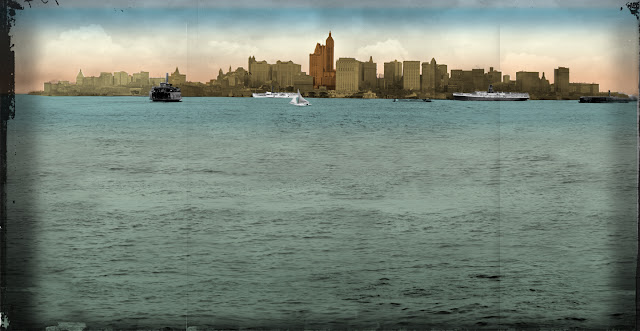 |
| the show's "logo" has the Hudson, the East River, Penn station, the NY skyline, a train and three typefaces. That is probably a record |
 |
| I created this as a mural in the show. It is pieced together from three 1908 skyline scenes like (but not including) the one below. I then added more water, colorized, and distressed it. |
 |
| tunelling under the Hudson |
 |
| West Street ferry terminals (The Pennsylvania Railroad one is in the far center, with a flag) |
The small exhibit I designed for the New York Transit Museum opened last week. The show is in the Transit's space in Grand Central Terminal, in the "shuttle passage."
A fair bit of the installation deals with the simultaneous mind-boggling feats of engineering that went into creating Pennsylvania Station:
A fair bit of the installation deals with the simultaneous mind-boggling feats of engineering that went into creating Pennsylvania Station:
tunneling under the Hudson River
tunneling across Manhattan
tunneling under the East River (to connect to the LIRR)
buying up several blocks of the West side of Manhattan
demolishing those blocks
blasting and excavating while shoring up the elevated subway, trying not to kill anyone
Then building the nine-acre structure.
*Design is how I make a living. In a manner of speaking, the museum and its show have contributed to the pleasure of my having a roof over my head as I update this blog. Thus, it is an unofficial sponsor.
tunneling across Manhattan
tunneling under the East River (to connect to the LIRR)
buying up several blocks of the West side of Manhattan
demolishing those blocks
blasting and excavating while shoring up the elevated subway, trying not to kill anyone
Then building the nine-acre structure.
Before the Pennsylvania Railroad got the bright idea to try to continue their train tracks into Manhattan, everyone had to disembark in New Jersey and change to a ferry. Arrival in New York would find you in the rather no-nonsense ferry dock. A weary cross-country traveller might very well collapse when the porter said, "So long! Dont take any wooden nickels!" as he left you in the midst of the chaos that was West Street (see above)... If you are passing Grand Central please go take a look— the exhibit is free.












